How to Connect: Celestion Speakers in a Guitar Cabinet Setup Guide
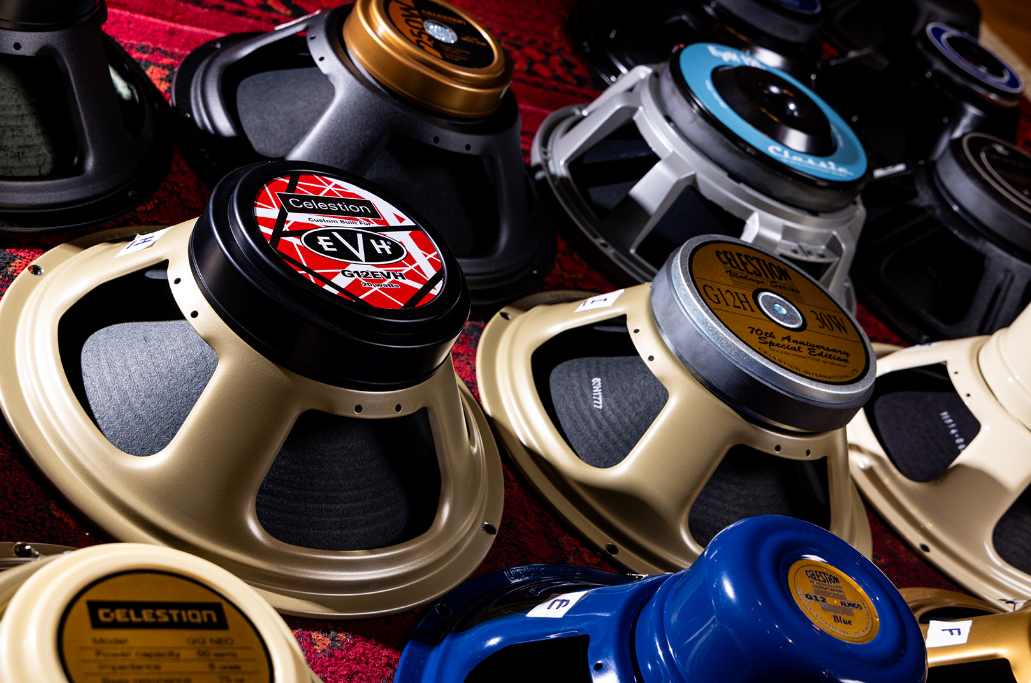
Content
Introduction of Celestion Speakers in a Guitar Cabinet
Celestion speakers have long been the go-to choice for guitarists seeking unparalleled tone and clarity. By installing Celestion speakers in your guitar cabinet, you can breathe new life into your sound, ensuring that your guitar's unique voice shines through. With various models available, you can find the perfect Celestion speakers for your specific musical style and budget. Prices typically range from $100 to $300 per speaker, depending on the model and features. While Celestion does not provide a specific launching date for these speakers, they continuously improve and expand their product line to meet the demands of modern guitarists.
Detailed Specifications
Key features of speakers include
- Power handling: The ability to handle high power levels without distortion or damage.
- Frequency response: The range of frequencies the speaker can accurately reproduce.
- Impedance: The speaker's resistance to electrical current, measured in ohms.
- Sensitivity: The speaker's efficiency, measuring the sound pressure level produced by a given input power.
- Voice coil: The wire-wrapped cylinder that moves the speaker cone, available in various materials like copper or aluminum.
- Magnet type and weight: Different magnet materials and weights can significantly affect tone.
- Cone material: The choice of cone material (e.g., paper, polymer, or composite) influences sound dispersion and durability.
THE BASICS
- POWER HANDLING
Speakers must be capable of taking at least as much power as the amp puts out, or you risk damaging them. So, for a single speaker, pick one with a power rating the same or higher than the amp itself. For a twin speaker combo the minimum speaker power rating is half that of the amp and for a cabinet with four speakers it will be a quarter of the amp's maximum power output. - IMPEDANCE
Just as important as power rating is impedance - given in Ohms (written - Ω). If you use the wrong value, then the amp may be damaged. Ensure that your new speaker has the same impedance as the speaker it is replacing. So, if you’re taking out an 8Ω speaker, make sure the replacement is also rated 8Ω. (Note - some vintage speakers are rated at 15Ω, you can use these to replace a 16Ω without fear of damage.)
ESSENTIAL TOOLS
Here's what you'll need
- The combo amplifier/cabinet you’ll be working on and the Celestion speakers you’re going to load into it.
- A screwdriver to remove the back panel of the combo/cabinet.
- The appropriate tool for the speaker bolts, for example a multi-wrench, allen key or screwdriver. Note that this will vary depending on the make of your combo/cabinet so be sure to check first.
- Pen and paper for making a note of the existing wiring connections.
- Pliers and electrical tape.
- Wire cutters/strippers and soldering equipment (required for speakers with a ‘solder only’ tag panel).
How to Connect the Speakers in a Guitar Cabinet
Make sure the amp is disconnected from the mains supply and you have allowed sufficient time for the tubes (if fitted) to cool down and discharge any residual voltage if you have used it recently. Check the terminals - are they ‘push on’ connectors or ‘solder only’ ?
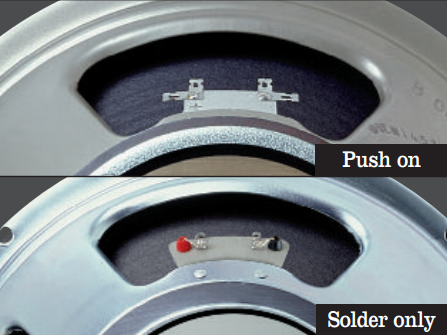
Remove the back panel from your combo/cabinet (where fitted) and make a note of which color wire goes to the + terminal of the speaker.
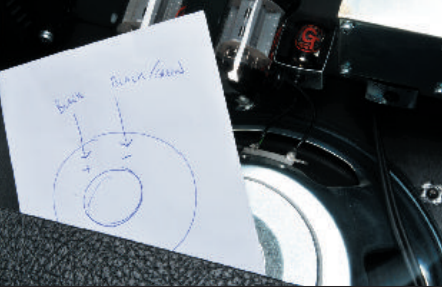
Disconnect the wires and get them safely out of the way using tape. Next, ensure the terminals are cleaned to achieve the best connection. Undo the bolts, then carefully remove the speaker(s) taking care not to damage the cone or anything inside your amp. Careful - you may find the speaker is slightly stuck to the front baffle and comes free suddenly. Place the speaker face down on a flat surface.

Carefully insert and bolt in the new speaker (take care when handling so as not to damage the cone). Finger tighten all bolts then tighten them with the appropriate tool, securing diagonally opposite bolts in sequence. Hand tight is fine, this will ensure that you don't bend the speaker frame.
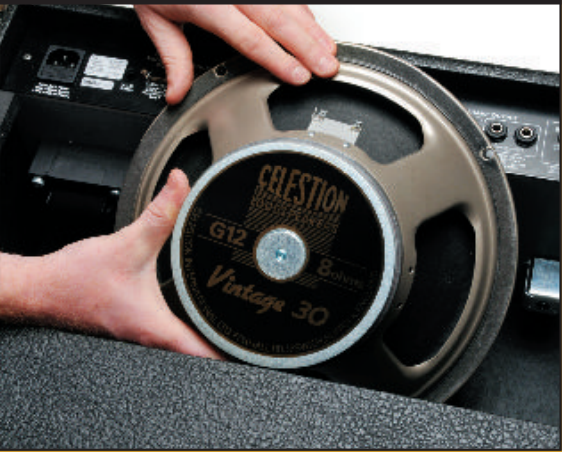
Connect the new speaker according to the wiring diagram you made earlier. Make sure all connections are solid and secure (you may need to tighten the clips using a pair of pliers.) If soldering, take precautions to ensure that hot solder cannot drip on to the speaker cone – it will cause damage. Re-check the wiring is correct!

- Once you’re confident that the wiring is correct, plug in and turn on at low volume. Check for buzzes or anything untoward. When everything sounds OK, put the panels back and you’re ready to go.
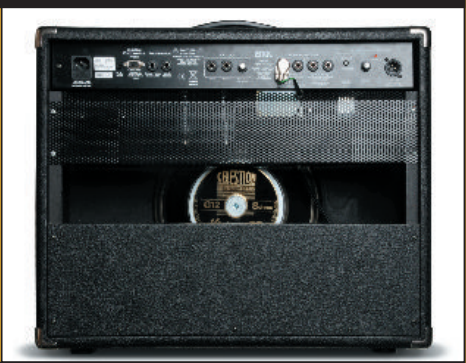
BREAKING IN YOUR SPEAKER
Brand new speakers usually require a “breaking in period”. Start with a few minutes of low-level playing or background hum. Next, turn up the power amp volume to full, control the level with the preamp gain and play with a fat, clean tone. Have the bass and mid up full, and the treble set to at least half. On your guitar, use the middle pickup position (if your guitar has more than one pickup) and play for 10-15 minutes using lots of open chords, and chunky percussive playing. This will get the cone moving, and should excite all the cone modes and get everything to settle in nicely.
Description of Speakers in a Guitar Cabinet
Celestion Speakers in a Guitar Cabinet deliver rich, detailed tones that provide exceptional clarity and warmth. Their Celestion Speakers in a Guitar Cabinet are engineered to meet the demands of professional guitarists who require consistent, high-quality sound. With various models, each with its unique sound characteristics, you can choose Celestion speakers that perfectly complement your playing style and guitar. Whether you're into blues, rock, metal, or any other musical genre, Celestion has the right speakers for you.
SAFETY FIRST
PLEASE READ BEFORE ATTEMPTING ANY WORK.
Ensure you have unplugged the amp from the mains electricity supply. Some amps, particularly those fitted with vacuum tubes, can retain dangerous voltages inside the chassis after they have been switched off and disconnected from the mains supply. Allow sufficient time for voltage discharge and tube cooling before following these steps.
Guitar speakers have large magnets which can affect audiovisual equipment including, but not limited to, television screens and computer monitors. Pick your location carefully and make sure you have plenty of room in which to work.
Troubleshooting
Common issues with speakers in a guitar cabinet include
- Blown speakers: Ensure that your amplifier's power output matches your speakers' power handling capabilities. Avoid overdriving the speakers.
- Distorted sound: Inspect your guitar's setup for potential issues, such as loose connections, frayed cables, or dirty pots. Also, check the amplifier's settings and your playing technique.
- Loss of bass or treble frequencies: Examine the cabinet's construction and the speaker's installation to ensure there are no obstructions or damage to the speakers.
Pros & Cons of Celestion Speakers
Pros
- Superb sound quality
- Wide range of models for different tonal preferences
- High-quality components and durable construction
- Compatibility with various amplifiers and musical genres
Cons
- Higher cost compared to some other speaker brands
- Power handling capacity might not accommodate high-gain amplifiers for some models
Customer Reviews of Celestion Speakers in a Guitar Cabinet
- “Celestion speakers transformed my guitar sound – the clarity and warmth are unbelievable!”
- “I've never experienced such detailed and rich tones in a guitar speaker – highly recommended!”
- “I swapped out my old speakers for Celestion models – the improvement was immediate and substantial.”
Faqs
Putting Celestion Speakers inside my guitar cabinet: what are the steps to take?
When installing Celestion Speakers, what must be taken into consideration with regard to impedance?
Do I have the ability to combine multiple versions of Celestion Speakers in my cabinet?
My Celestion Speaker cabinet does not produce any sound; what could be the cause of this?
If I have a closed-back cabinet, what are some ways that I may get the finest tone out of my Celestion Speakers?
How long does it take for new Celestion guitar speakers to reach their break-in point?
What steps can I take to ensure that my Celestion Speakers last as long as possible?
If my Celestion Speaker is making a buzzing or rattling sound, what should I do?
I have Celestion Speakers in my guitar cabinet; what is the best way to clean them?
Does the Celestion Speakers come with a warranty, and if so, how do I go about claiming it?
Leave a Comment
